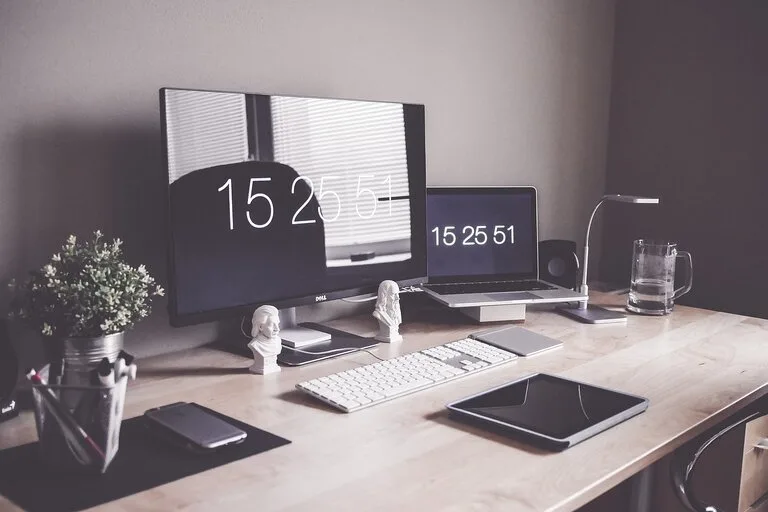How to Connect Laptop to Laptop Using HDMI? Are you trying to connect the screen of your laptop to another laptop? Using an HDMI cable to connect your computers is a straightforward and time-saving method to do this task. We will guide you through the process of connecting your laptop to another laptop using HDMI.
If you follow these instructions, you will quickly be able to share your screen with other people. HDMI is a common digital interface for sending audio and video signals from one device to another, and it makes it easy to share content on a bigger screen.
In this blog post, we’ll explain in detail how to use HDMI to connect one laptop to another. We’ll talk about the tool, and steps, you’ll need to make sure your connection goes smoothly and works. This guide will help you get the most out of your laptop’s HDMI ports, PC Power Supply, whether you’re giving a presentation, working with others, or just want to watch a movie with others.
Here’s a detailed guide on how to do it:

How to Connect Laptop to Another Laptop Using HDMI 5 Easy Steps
How to Connect Laptop to Laptop Using HDMI
Step 1: Make sure that both laptops have HDMI ports. You can still link the two devices even if one of the laptops does not have an HDMI port by making use of a different technique such as a USB-C to HDMI adapter or a wireless display adapter.
Step 2: Attach one end of the HDMI cable to the laptop’s HDMI port using the matching connector.
Step 3: Attach the other end of the HDMI cable to the port on the second laptop that is designated for HDMI connections.
Step 4: On the first laptop, switch to an external display by pressing the key combination that is specific to your operating system. For example, on a Windows laptop, this would be “FN + F5”; on a Mac laptop, it would be “Command + F2.”
Step 5: Select “Duplicate” or “Extend” for the display mode on the second laptop, depending on how you want to utilise the two computers together.
If you are connecting the adapter to both computers via a USB-C to HDMI converter or a wireless display adapter, make sure to follow the instructions provided by the manufacturer of the adapter.
In order for the wireless connection to be successful, you will need to ensure that both computers are linked to the same local network, which can be a Wi-Fi network.
Troubleshooting Tips:
In the event that you are experiencing problems connecting the two laptops to one another, check to see that the HDMI cable is properly connected to both of the devices and that the computers in suggestion are switched on.
If one of the laptops is not able to recognise the other laptop, you should try switching to an external display by pressing the key combination that is specific to your operating system on both of the computers.
Make sure that both laptops are connected to the same local network and that the adapter is properly configured if you are attempting to use a wireless display adapter and the connection is not working.
If you follow these instructions, you should be able to connect your laptop to another laptop via the HDMI cable with no trouble.
Note: These steps may be a little different depending on the operating system and how the laptops are set up. Also, make sure that the host laptop’s resolution and refresh rate work with the HDMI cable and the client laptop. If you are having trouble, try a different HDMI port or cable.
Why My Laptop is Not Displaying Through HDMI?
1. Make sure that the HDMI cable is securely attached to both the laptop and the display device (such as a TV or monitor).
2. Check to see if your laptop’s HDMI port is working right. If you have another device, like a Blu-ray player or game console, that you can use to test the port, connect that device to see if it works.
3. If you are using an HDMI-to-DVI adapter, make sure it is properly connected and that the DVI cable is securely plugged into the display device.
4. Check your laptop’s settings to make sure that it is set up to send video to a separate screen. To switch between display modes, you may need to press a certain key combination, like “FN + F5”
5. If you’re using a wireless display adapter, make sure it’s set up right and that both your laptop and the device you want to display on are connected to the same network.
If you’ve tried all of these steps and your laptop still won’t show up through HDMI, there may be a problem with your laptop’s HDMI port. In this case, you might need an expert to fix your laptop.
What If My Laptop Has No HDMI Port?
Even if one of the laptops does not have an HDMI port, you can still link the two devices by making use of a different way such as a USB-C to HDMI adapter or a wireless display adapter.
- Connect the USB-C to HDMI adapter to the laptop’s USB-C port. If the laptop does not have an HDMI port, you will need to use an adapter that can convert USB-C to HDMI. After that, follow the steps outlined above to connect the HDMI cable to both the adapter and the second laptop.
- If you are utilizing a wireless display adapter, ensure that you connect the adapter to both laptops in accordance with the instructions provided by the manufacturer. In order for the wireless connection to be functional between the two laptops, you will need to ensure that both of the laptops are linked to the same local network, such as a Wi-Fi network.
How to Transfer Data From Laptop to Laptop Using HDMI Cable
It is not possible to transfer data directly from one laptop to another using an HDMI cable. HDMI is a video and audio interface that is mostly used to connect a device (like a laptop) to a display (such as a TV or monitor).
You can connect two laptops with an HDMI cable and show the screen of one laptop on the other, but you can’t use it to send data from one laptop to the other.
There are several other ways to move data from one laptop to another:
Use a USB flash drive. Connect a USB flash drive to one of the laptops and copy the data you want to move onto it. Then, take the flash drive out of one laptop and plug it into the other to get to the data that was transferred.
Use a network connection. If both laptops are connected to the same local network, such as a Wi-Fi network, you can share files between them using tools like Windows File Explorer or macOS Finder.
Use a cloud storage service. If you have an account with Google Drive or Dropbox, you can upload the data you want to move to the cloud and then download it to the other laptop.
Use an external hard drive. Connect an external hard drive to one of the laptops and copy the data you want to move onto it. Then, unplug the hard drive and plug it into the other laptop to get to the data that was moved.
Also Read
How to Connect Laptop to Another Laptop Using USB
How to Connect Laptop to Another Laptop Using VGA
How to Connect Laptop to Another Laptop Using LAN
Conclusion
HDMI lets you easily share videos, photographs, and presentations on a larger screen. This instruction will let you link two computers using an HDMI cable and the right ports. First, ensure both computers have HDMI ports (or use adapters to convert other ports to HDMI). Turn off both laptops and attach an HDMI cable to the host laptop and the client laptop. Start both computers and pick the display mode on the client laptop’s “Project” menu (either “Duplicate” or “Extend”). Finally, open the file or app on the host laptop and adjust the display settings. Use your laptop’s HDMI capabilities to share material on a larger screen with these simple steps.
FAQ’s
How do i connect my laptop to my tv without HDMI?
You can still connect your laptop to your TV even if it doesn’t have an HDMI port or you can’t use an HDMI connection.
You could use an adapter with a VGA or DVI cable, a USB-C to HDMI adapter, a wireless display adapter, a streaming device, or screen mirroring, among other things. Before you try to connect your laptop and TV, make sure they both have the right ports and can work together.
How do i get my laptop to recognize HDMI?
Secure the HDMI cord to the laptop and display device (such as a TV or monitor).
Test your laptop’s HDMI port. Connect a Blu-ray player or game console to test the port.
Make sure your HDMI-to-DVI converter is correctly connected and the DVI wire is securely plugged into the display device.
Make sure your laptop is set to output video to an external display. To switch display modes, press “FN + F5”.
Make sure your laptop and display device are on the same network and your wireless display adapter is properly configured.




